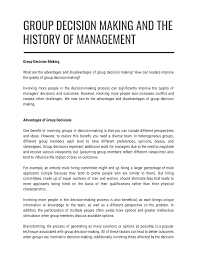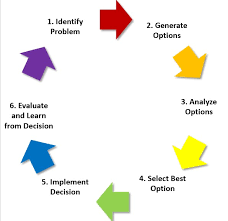The Ideal Decision Making Model to Use
When it comes to making important decisions, having a structured decision-making model can be incredibly beneficial. One of the most widely used and effective decision-making models is the Rational Decision Making Model.
The Rational Decision Making Model is ideal to use because it follows a logical step-by-step process that can help individuals make well-thought-out decisions. This model typically involves the following steps:
- Identifying the decision to be made
- Gathering relevant information
- Identifying alternatives
- Evaluating the alternatives based on criteria
- Making the decision
- Implementing the decision
- Evaluating the outcome
By following this structured approach, individuals can ensure that they consider all relevant factors, weigh their options carefully, and ultimately make a decision that is based on logic and reason.
Furthermore, using a decision-making model like the Rational Decision Making Model can help individuals avoid common pitfalls such as making impulsive decisions or being influenced by emotions.
In conclusion, when faced with an important decision, using a structured decision-making model like the Rational Decision Making Model can greatly increase the likelihood of making a sound and well-informed choice.
8 Essential Tips for Effective Decision Making: A Guide to Choosing the Right Model
- Clearly define the decision to be made.
- Gather all relevant information before making a decision.
- Consider the potential consequences of each option.
- Evaluate the risks and benefits associated with each alternative.
- Involve key stakeholders in the decision-making process.
- Use a systematic approach, such as SWOT analysis or decision matrices.
- Take your time to make an informed decision; avoid rushing.
- Reflect on past decisions to learn and improve future decision-making.
Clearly define the decision to be made.
One crucial tip in utilizing the ideal decision-making model is to clearly define the decision that needs to be made. By precisely outlining the decision at hand, individuals can focus their efforts on gathering relevant information, identifying alternatives, and evaluating potential outcomes more effectively. Clarity in defining the decision helps streamline the decision-making process and ensures that all subsequent steps are aligned with the ultimate goal, leading to a more informed and rational decision.
Gather all relevant information before making a decision.
Gathering all relevant information before making a decision is a crucial tip when using a decision-making model. By ensuring that you have all the necessary facts, data, and insights at hand, you can make a more informed and rational decision. This step allows you to consider all aspects of the situation, weigh the pros and cons of different options, and ultimately make a well-thought-out choice that aligns with your goals and values. Taking the time to gather relevant information can help minimize risks, increase the likelihood of success, and lead to more confident decision-making outcomes.
Consider the potential consequences of each option.
When utilizing a decision-making model, such as the Rational Decision Making Model, it is crucial to consider the potential consequences of each option. By carefully evaluating the outcomes and implications of each choice, individuals can make more informed decisions that align with their goals and values. Taking the time to assess the potential consequences can help mitigate risks, maximize benefits, and ensure that the chosen option is the most suitable for the given situation. This thoughtful consideration of consequences is essential for making sound decisions that lead to positive outcomes in both personal and professional contexts.
Evaluate the risks and benefits associated with each alternative.
When utilizing a decision-making model, such as the Rational Decision Making Model, it is crucial to evaluate the risks and benefits associated with each alternative. By carefully assessing the potential advantages and drawbacks of each option, individuals can make more informed decisions that take into account all relevant factors. This step allows for a comprehensive analysis of the potential outcomes of each alternative, ultimately leading to a more strategic and well-thought-out decision-making process.
Involve key stakeholders in the decision-making process.
Involving key stakeholders in the decision-making process is a crucial tip when utilizing an ideal decision-making model. By engaging individuals who are directly impacted by the decision or who have valuable insights to contribute, a more comprehensive and well-rounded perspective can be achieved. This collaborative approach not only promotes transparency and inclusivity but also increases the likelihood of reaching a consensus that considers diverse viewpoints and aligns with the overall goals and values of the stakeholders involved.
Use a systematic approach, such as SWOT analysis or decision matrices.
When it comes to making decisions, using a systematic approach such as SWOT analysis or decision matrices can be highly beneficial. These tools provide a structured framework for evaluating options, weighing pros and cons, and ultimately making informed decisions. By conducting a SWOT analysis (assessing strengths, weaknesses, opportunities, and threats) or using decision matrices to compare different criteria, individuals can gain valuable insights that can guide them towards the best course of action. This systematic approach helps in organizing thoughts, clarifying priorities, and ensuring that all relevant factors are taken into consideration before making a decision.
Take your time to make an informed decision; avoid rushing.
Taking your time to make an informed decision and avoiding rushing is a crucial tip when using a decision-making model. Rushing through the decision-making process can lead to overlooking important factors, making hasty judgments, and ultimately regretting the outcome. By allowing yourself the time needed to gather information, weigh options, and carefully evaluate alternatives, you can make a more thoughtful and well-informed decision that aligns with your goals and values. Remember, patience is key when it comes to making decisions that will have a significant impact on your life.
Reflect on past decisions to learn and improve future decision-making.
Reflecting on past decisions is a valuable tip when using the decision-making model, as it allows individuals to learn from their experiences and improve their future decision-making process. By analyzing past decisions, one can identify what worked well and what could have been done differently. This self-reflection helps in gaining insights into one’s decision-making patterns, strengths, and areas for growth. Ultimately, by learning from past decisions, individuals can make more informed and effective choices in the future.




